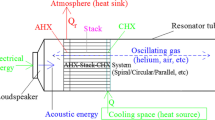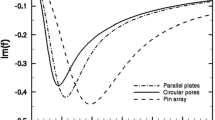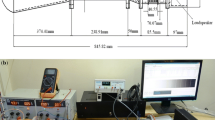Abstract
The novelty of this work is a new type of stack, namely, the parallel wave stack (PWS). In this paper, we study the performance of an air-based standing wave thermoacoustic refrigerator using the PWS. We use small heat pipes with a heat transfer rate of approximately 30 W as heat exchangers for the system. We investigate the effect of the ratio of stack length (Ls) to the distance between stack center and reflector (Xs) on the performance of the refrigerator parallel wave stacks with a blockage ratio (BR) of 67 %, 71 %, and 74 %, and with Ls/Xs ratios of 0.74, 0.96, and 1.20. We tested and compared these under a cooling load (Qc) of 0.5 W to 2 W and a frequency of 150 Hz. The results show that a BR of 71% with an Ls/Xs ratio of 0.96 provides a minimum cold-side temperature (Tc), and a maximum temperature difference (ΔTm), a maximum coefficient of performance, and a maximum relative coefficient of performance. This new type of stack can provide a higher performance. The structure of the stack is also stronger than others. This stack is an alternative and can be used in a thermoacoustic refrigerator. The results obtained from the present study will be very useful for improving the performance of the thermoacoustic refrigerator in the future.








Similar content being viewed by others
Data Availability
Data sharing not applicable to this article as no datasets were generated or analyzed during the study. We do not wish to share our data at this moment because the next step of this research is going on and would like to keep the data until the project is finished.
Abbreviations
- As :
-
Heat transfer area (m2)
- PWS:
-
Parallel wave stack
- BR:
-
Blockage ratio (%)
- Qc :
-
Cooling load (W)
- COP:
-
Coefficient of performance
- TAR:
-
Thermoacoustic refrigerator
- COPc:
-
Carnot coefficient of performance
- Tc :
-
Cold-side temperature (°C)
- COPR:
-
Relative coefficient of performance
- Th :
-
Hot-side temperature (°C)
- Ei :
-
Electrical input voltage (V)
- Xs :
-
Distance between stack center and reflector (m)
- f:
-
Frequency (Hz)
- Ii :
-
Electrical input current (A)
- Ls :
-
Stack length (m)
- ρm :
-
Mean density (kg·m−3)
- Pi :
-
Electrical input power (W)
- ΔTm :
-
Temperature difference (°C)
References
N. Rott, Thermoacoustics. Adv. Appl. Mech. 20, 135–175 (1980)
T.J. Hofler, Thermoacoustic refrigerator design and performance, Ph.D. Dissertation, Physics Department, University of California at San Diego, 1986.
G.W. Swift, Thermoacoustic engines. J. Acoust. Soc. Am. 84, 1145–1180 (1988)
S.L. Garrett, J.A. Adeff, T.J. Hofler, Thermoacoustic refrigerator for space applications. J. Thermophys. Heat Transf. 7, 595–599 (1993)
G.W. Swift, Thermoacoustic engines and refrigerators. Phys. Today 48, 22–28 (1995)
M. Wetzel, C. Herman, Design optimization of thermoacoustic refrigerators. Int. J. Refrig. 20, 3–21 (1997)
J.R. Belcher, W.V. Slaton, R. Raspet, H.F. Bass, J. Lightfoot, Working gases in thermoacoustic engines. J. Acoust. Soc. Am. 105, 2677–2684 (1999)
M.E. Poese, S.L. Garret, Performance measurements on a thermoacoustic refrigerator driven at high amplitudes. J. Acoust. Soc. Am. 107, 2480–2486 (2000)
M.E.H. Tijani, J.C.H. Zeegers, A.T.A.M. de Waele, Construction and performance of a thermoacoustic refrigerator. Cryogenics 42, 59–66 (2002)
M.E.H. Tijani, J.C.H. Zeegers, A.T.A.M. de Waele, Design of thermoacoustic refrigerators. Cryogenics 42, 49–57 (2002)
C. Herman, Y. Chen, A simplified model of heat transfer in heat exchangers and stack plates of the thermoacoustic refrigerators. Heat Mass Transfer 42, 901–917 (2006)
M. Akhavanbazaz, M.H.K. Siddiqui, R.B. Bhat, The impact of gas blockage on the performance of a thermoacoustic refrigerator. Exper. Therm. Fluid Sci. 32, 231–239 (2007)
E.C. Nsofor, A. Ali, Experimental study on the performance of the thermoacoustic refrigerating system. Appl. Therm. Eng. 29, 2672–2679 (2009)
S.H. Tasnim, S. Mahmud, R.A. Fraser, Effects of variation in working fluids and operating conditions on the performance of a thermoacoustic refrigerator. Int. Commun. Heat Mass Transfer 39, 762–768 (2012)
B.R. Nayak, G. Pundarika, B. Arya, Influence of stack geometry on the performance of thermoacoustic refrigerator. Indian Acad. Sci. 42, 223–230 (2017)
S.G. Yahya, X. Mao, A.J. Jaworski, Experimental investigation of thermal performance of random stack materials for use in standing wave thermoacoustic refrigerators. Int. J. Refrig. 75, 52–63 (2017)
C. Wantha, The impact of stack geometry and mean pressure on cold end temperature of stack in thermoacoustic refrigeration systems. Heat Mass Transf. 54, 2153–2161 (2018)
P. Chaiwongsa, S. Wongwises, Experimental investigation on the performance of the air−based standing wave thermoacoustic refrigerator using heat pipe as heat exchangers. Int. J. Air Cond. Refrig. 28, 1–16 (2020)
P. Chaiwongsa, S. Wongwises, Effect of the blockage ratios of circular stack on the performance of the air-based standing wave thermoacoustic refrigerator using heat pipe, Case Stud. Therm. Eng. 24, 1–13 (2021)
Acknowledgments
The authors acknowledge the National Research Council of Thailand (NRCT) for the Research and Researchers Funds for Industries (RRI), Mr. Thunyawat Chittiphalungsri from Saijo Denki International Co. Ltd., the NSTDA for the Research Chair Grant, and the Thailand Science Research and Innovation (TSRI) for Fundamental Fund 2022.
Author information
Authors and Affiliations
Corresponding author
Ethics declarations
Conflict of interests
The authors declare that they have no competing interests.
Additional information
Publisher's Note
Springer Nature remains neutral with regard to jurisdictional claims in published maps and institutional affiliations.
Rights and permissions
About this article
Cite this article
Chaiwongsa, P., Wongwises, S. Experimental Study of the Performance of the Air-Based Standing Wave Thermoacoustic Refrigerator Using Parallel Wave Stack. Int J Thermophys 43, 152 (2022). https://doi.org/10.1007/s10765-022-03070-5
Received:
Accepted:
Published:
DOI: https://doi.org/10.1007/s10765-022-03070-5




